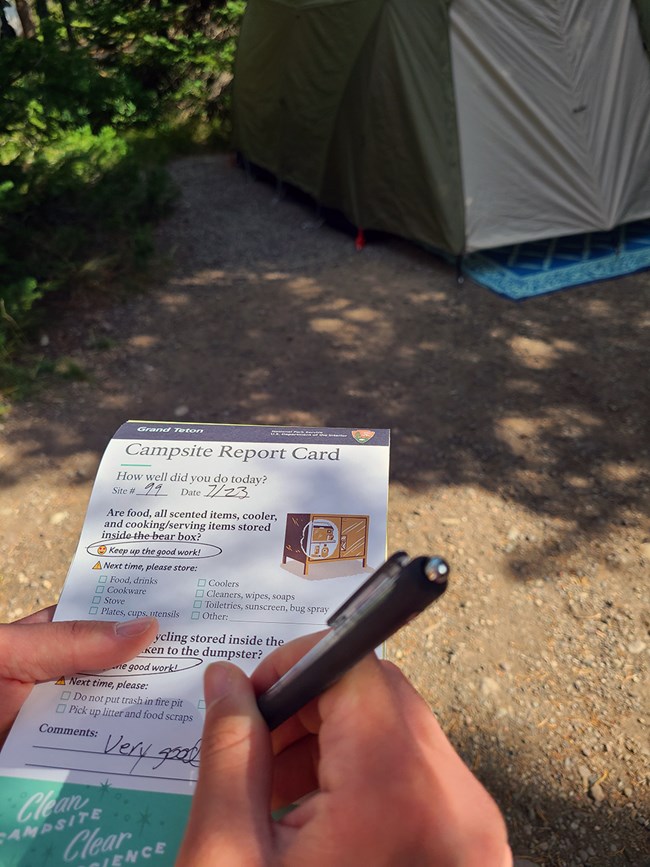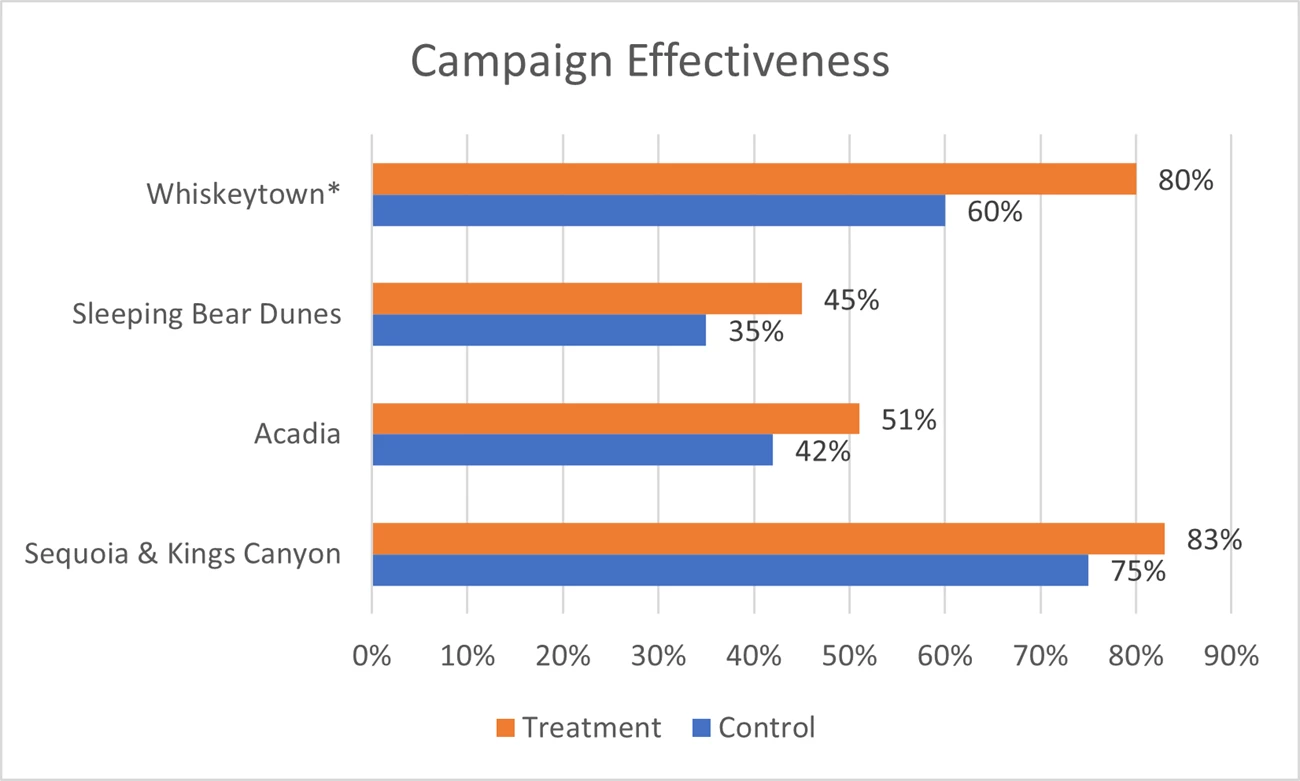Last updated: January 17, 2023
Article
Clean Campsite, Clear Conscience – A campaign to encourage proper food storage in picnic areas and campgrounds

CSU/Katie Abrams
Each year, millions of people come to picnic and camp in national parks. Food and crumbs left out by visitors becomes a health and safety concern for people and wildlife and can turn a good day bad. To encourage visitors to properly store their food, researchers designed, implemented, and evaluated a campaign to encourage voluntary compliance with food storage guidelines and regulations.
Importance of proper food storage
Improper food storage can have consequences for people and wildlife. When people leave food out, it can attract wildlife, including their unwanted droppings, as well as unwelcomed insects. For wildlife, risks to wildlife from eating human food are great and can include poor nourishment and shorter lives. Proper food storage in picnic areas and campgrounds helps ensure a safe and enjoyable visitor experience and protects the health and safety of wildlife. It may seem easy and logical for people to follow the rules to protect themselves and wildlife, but in practice it takes work to diligently keep a clean site while on vacation.
Clean Campsite, Clear Conscience
Researchers at Colorado State University and Ohio State University designed an experimental campaign promoting the slogan, “Clean Campsite, Clear Conscience.” They implemented and evaluated the campaign five national parks - Acadia National Park, Sleeping Bear Dunes National Lakeshore, Sequoia and Kings Canyon National Parks, Whiskeytown National Recreation Area, and Grand Teton National Park. The researchers used a social marketing-based approach to increase camper and picnicker compliance with park rules and guidelines for managing their wildlife attractants, e.g., food, trash, and scented items.
Social marketing applies traditional marketing principles alongside theories and concepts from behavioral economics, behavior change, and communication to create initiatives aimed specifically at shaping and changing people’s behavior in ways that benefits society (Lee & Kotler, 2019). The Clean Campsite, Clear Conscience campaign included simplified instructional messages paired with persuasive appeals and tactics that aligned the compliant behaviors with campers’ desired camping experience and an emotional driver to avoid feelings of guilt. The approach also included positive and negative feedback via campsite report cards, a dynamic norm message, and packing tips that, if followed, would make compliance easier. The slogan and supportive messaging aligned the desired behaviors with having a clear conscience or clear mind and avoiding the stress of having to deal with pests, property damage, and/or social embarrassment. Other message framing and behavior change techniques used shown to be effective in previous research (see Van Leuvan et al., 2022) in the campaign included:
-
making the desired behaviors easy by providing packing and organization tips to facilitate compliance, and simplifying the desired behaviors to three key behavior-focused messages with a rhyming summary message (“An arm’s reach away? You’re okay! Otherwise, put it away.”),
-
elevating risk perceptions (disgust from animal feces and pests, cleanup, social embarrassment, losing relaxation time, property loss and damage, fines),
-
prompts or cues for action by strategically placing signage and visuals that reinforce behavioral messages,
-
dynamic norms messaging to persuade people to comply with the trending norm of better managing wildlife attractants, and
-
positive and negative feedback provided through campsite report cards.
Methods
Researchers conducted field studies to test the effectiveness of the campaign. In treatment areas, existing park signage was covered, and campers and picnickers received information with the campaign messages. Researchers observed whether food or attractants were left out, proximity of people to attractants, and presence of people. The campaign was test at a picnic area at Whiskeytown National Recreation Area in 2020, and at campgrounds at Acadia National Park, Sleeping Bear Dunes National Lakeshore, and Sequoia and Kings Canyon National Parks in 2021. The campaign was also evaluated at Grand Teton National Park in 2022 and data are being analyzed.
Results
At each site researchers observed increased compliance with food storage guidelines and regulations. Campers were marked as compliant using the following criteria:
-
People present and <3 feet of all attractants = in compliance
-
People present and no attractants are out = in compliance
-
No people present and no attractants out = in compliance
-
Attractants out, no people present = out of compliance
-
People present, <3 feet of only some or none of the attractants = out of compliance
-
Those that did not meet the criteria 1-5, but water or plastic storage bins were the only attractants left out = in compliance

*At Whiskeytown, researchers observed the number of day-use visitors in compliance with site storage regulations when existing park messaging was in place followed by observations when messaging informed by the social marketing framework was in place.
CSU/Katie Abrams
Recommendations
Encouraging proper food storage among visitors on vacation is challenging. Social marketing recognizes that “people change not only because they are well informed or forced into action, but also because they get something they value in return. The process of developing behavior change approaches in social marketing attempts to reduce the cost and increase the benefits of the new behavior” (Smith, 2006). This campaign used strategies such as prompts and cues for action, vivid and memorable graphics and messaging, and increasing the perceived benefits to visitors by reducing psychological distance. The benefits to visitors were a clear conscience and positive experience. The following recommendations can be used by natural areas and land managers interested in applying a social marketing approach to increase compliance with food storage guidelines.
Make desired behaviors vivid and memorable
Simplifying the desired behavior to a key message and associating it with personally meaningful benefits (and risks if the desired behaviors were not performed) was also possibly impactful. The key message being anything that has or could have a scent, even if clean, should be put away properly or kept within arm’s reach. Rhyming, alliteration, using easy to remember references to distance, “An arm’s reach away, you’re okay! If not, put it away,” and illustrating examples of desired behavior on the graphics all help make the behaviors vivid and memorable.
Increase perceived benefits by reducing psychological distance
Park visitors and most people do care about wildlife; however, those feelings may not be strong enough to compel everyone to follow wildlife protection rules. As with many social marketing efforts targeting behaviors wherein impacts are not immediate or directly beneficial, using approaches that relate to what people care about in the near term can improve effectiveness. This campaign considered one of the top reasons people choose to camp is to “get away” from their everyday life that feels busy and manufactured (Kampgrounds of America, 2021), seek restoration, and reduce stress (Garst et al., 2009). Feelings of having a clear mind or clear conscience may connect with this same motivator. Aligning the desired behaviors with other more immediate and likely stressors of pests, property loss and damage, and embarrassment that put those restoration and stress-reduction goals at risk and likely increased perceived benefits of following park guidelines.
Reduce behavioral barriers: These behaviors begin at home
It is especially important to provide packing and unpacking organizational tips to visitors before they leave their home (e.g., by email or through websites) so compliance with rules for managing wildlife attractants is easier (i.e., reduces the behavioral barrier). For example, communication upon registering for a campsite can remind visitors to pack their food in easy-to-carry containers so they can place in their vehicle or park-supplied container when not in use.
For infrequent attractants: A role for interpersonal communication and light and heavy enforcement
The relative infrequency with which some attractants like food and flavored beverages are left out suggests additional interpersonal communication and enforcement approaches have a role to play in encouraging campers to comply with these rules for managing wildlife attractants. Positive feedback for following rules using courtesy contacts or report cards functions as a cue and a reward when people feel that their actions have been correct and appreciated. Positive feedback enhances feelings of achievement and increases motivation (Jenkins et al., 2015). Law enforcement actions, such as warnings, confiscation of items or citations, can also play a role in this case for repeat offenders who require additional, immediate and steeper consequences.
Apply the social marketing framework with more than signs
When it comes to addressing noncompliant behaviors among visitors, social marketing cannot achieve behavior change among all audiences through signs alone (Lee & Kotler, 2019; Abrams et al., 2019). Visitors’ decision-making and behaviors are influenced by the cues in the built and natural environment, wildlife behavior, social norms, and their own expectations and demographics. Signs, handouts, websites, social media, and scripts for interpersonal communication should all be designed with the goal of changing audience behavior. For example, in the approach studied in Sequoia and Acadia, researchers included feedback via report cards to shape behavior through praise and gentle correction. It also included tips to guide packing and organization of items upon unpacking at arrival in order to reduce barriers to complying with park rules for wildlife attractants.
